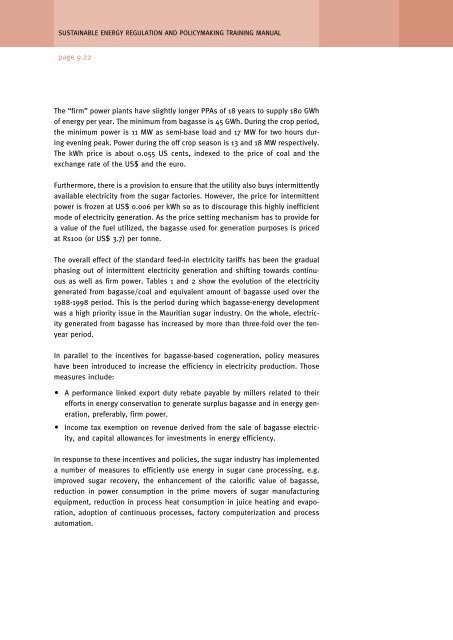Regulatory and policy options to encourage development of ...
Regulatory and policy options to encourage development of ...
Regulatory and policy options to encourage development of ...
- No tags were found...
You also want an ePaper? Increase the reach of your titles
YUMPU automatically turns print PDFs into web optimized ePapers that Google loves.
SUSTAINABLE ENERGY REGULATION AND POLICYMAKING TRAINING MANUALpage 9.22The “firm” power plants have slightly longer PPAs <strong>of</strong> 18 years <strong>to</strong> supply 180 GWh<strong>of</strong> energy per year. The minimum from bagasse is 45 GWh. During the crop period,the minimum power is 11 MW as semi-base load <strong>and</strong> 17 MW for two hours duringevening peak. Power during the <strong>of</strong>f crop season is 13 <strong>and</strong> 18 MW respectively.The kWh price is about 0.055 US cents, indexed <strong>to</strong> the price <strong>of</strong> coal <strong>and</strong> theexchange rate <strong>of</strong> the US$ <strong>and</strong> the euro.Furthermore, there is a provision <strong>to</strong> ensure that the utility also buys intermittentlyavailable electricity from the sugar fac<strong>to</strong>ries. However, the price for intermittentpower is frozen at US$ 0.006 per kWh so as <strong>to</strong> discourage this highly inefficientmode <strong>of</strong> electricity generation. As the price setting mechanism has <strong>to</strong> provide fora value <strong>of</strong> the fuel utilized, the bagasse used for generation purposes is pricedat Rs100 (or US$ 3.7) per <strong>to</strong>nne.The overall effect <strong>of</strong> the st<strong>and</strong>ard feed-in electricity tariffs has been the gradualphasing out <strong>of</strong> intermittent electricity generation <strong>and</strong> shifting <strong>to</strong>wards continuousas well as firm power. Tables 1 <strong>and</strong> 2 show the evolution <strong>of</strong> the electricitygenerated from bagasse/coal <strong>and</strong> equivalent amount <strong>of</strong> bagasse used over the1988-1998 period. This is the period during which bagasse-energy <strong>development</strong>was a high priority issue in the Mauritian sugar industry. On the whole, electricitygenerated from bagasse has increased by more than three-fold over the tenyearperiod.In parallel <strong>to</strong> the incentives for bagasse-based cogeneration, <strong>policy</strong> measureshave been introduced <strong>to</strong> increase the efficiency in electricity production. Thosemeasures include: A performance linked export duty rebate payable by millers related <strong>to</strong> theirefforts in energy conservation <strong>to</strong> generate surplus bagasse <strong>and</strong> in energy generation,preferably, firm power. Income tax exemption on revenue derived from the sale <strong>of</strong> bagasse electricity,<strong>and</strong> capital allowances for investments in energy efficiency.In response <strong>to</strong> these incentives <strong>and</strong> policies, the sugar industry has implementeda number <strong>of</strong> measures <strong>to</strong> efficiently use energy in sugar cane processing, e.g.improved sugar recovery, the enhancement <strong>of</strong> the calorific value <strong>of</strong> bagasse,reduction in power consumption in the prime movers <strong>of</strong> sugar manufacturingequipment, reduction in process heat consumption in juice heating <strong>and</strong> evaporation,adoption <strong>of</strong> continuous processes, fac<strong>to</strong>ry computerization <strong>and</strong> processau<strong>to</strong>mation.










